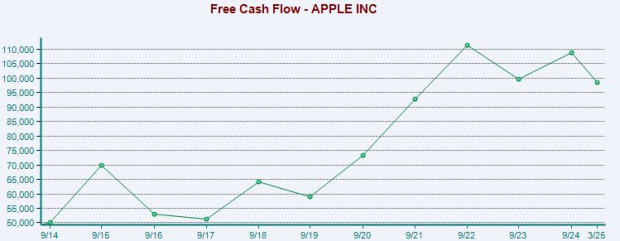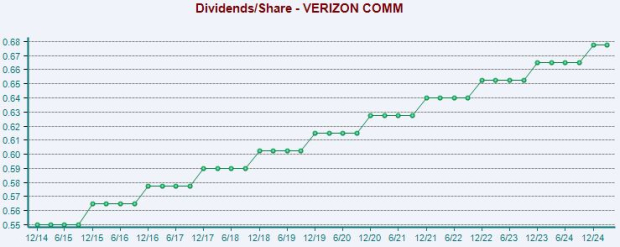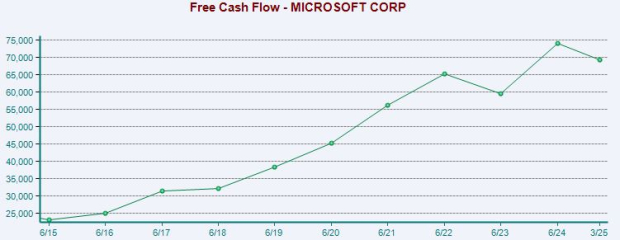Strong cash flows reflect financial stability, allowing companies to pay down debt, pursue growth opportunities, and shell out dividend payments.
These companies are also better equipped to weather downturns, providing another beneficial advantage for investors from a long-term standpoint.
And for those seeking cash-generating machines, three companies – Microsoft MSFT, Verizon VZ, and Apple AAPL – fit the criteria nicely. Let’s take a closer look at how each currently stacks up.
Apple Remains Cash King
Apple has long been a cash-generating machine, providing many benefits over the years, including higher dividend payouts. In fact, Apple has raised its quarterly payout in 13th consecutive years, now more than halfway to becoming a Dividend Aristocrat.
Shares yield a modest 0.5% annually, though the company’s 4.9% five-year annualized dividend growth helps bridge the gap. The tech titan generated $108.8 billion in free cash flow throughout its FY24, with flows remaining on a steady uptrend over the years.
Please note that the final value in the chart below is calculated on a trailing twelve-month basis, as AAPL’s current fiscal year is still ongoing.

Image Source: Zacks Investment Research
Verizon Keeps Generating Cash
Verizon’s strong cash-generating abilities have positioned it at the top of many income-focused investors’ lists, with the company close to joining the elite Dividend Aristocrats club thanks to years of consistently higher payouts.
Below is a chart illustrating the company’s dividends paid per share on a quarterly basis. FY24 free cash flow of $19.8 billion grew 6% year-over-year. Shares currently yield a steep 6.2% annually, crushing that of the S&P 500.

Image Source: Zacks Investment Research
Its latest set of quarterly results exceeded both Zacks Consensus EPS and Sales estimates modestly. Continued customer growth has been a nice tailwind for the company, with its broadband market share continuing to grow.
Microsoft Cloud Impresses
Concerning headline figures in its latest release, EPS of $3.46 and sales of $70.0 billion both handily exceeded our consensus expectations, continuing its recent streak of better-than-expected results. Sales grew an impressive 13% year-over-year, whereas EPS climbed 18%.
Microsoft Cloud and AI strength drove the strong results, with Microsoft Cloud revenue soaring 20% year-over-year to $42.4 billion. Demand has remained strong for the tech titan, with commentary alluding to the trend remaining for years to come.
Importantly, its Intelligent Cloud (includes Azure) revenue totaled a strong $26.8 billion, up 21% from the year-ago period. Like AAPL, strong cash flows have aided its shareholder-friendly nature, with Microsoft sporting a 10.3% five-year annualized dividend growth rate while also generating $69.4 billion in free cash flow over the trailing twelve months, as shown below.
 Image Source: Zacks Investment Research
Image Source: Zacks Investment Research
Bottom Line
Companies with strong cash-generating abilities are great targets, as they have plenty of cash to fuel growth, pay out dividends, and easily wipe out debt. And as mentioned above, these companies are better equipped to handle an economic downturn, undeniably a positive.
For those seeking cash-generators, all stocks above – Microsoft MSFT, Verizon VZ, and Apple AAPL – fit the criteria nicely.
Higher. Faster. Sooner. Buy These Stocks Now
A small number of stocks are primed for a breakout, and you have a chance to get in before they take off.
At any given time, there are only 220 Zacks Rank #1 Strong Buys. On average, this list more than doubles the S&P 500. We’ve combed through the latest Strong Buys and selected 7 compelling companies likely to jump sooner and climb higher than any other stock you could buy this month.
You’ll learn everything you need to know about these exciting trades in our brand-new Special Report, 7 Best Stocks for the Next 30 Days.
Download the report free now >>
Apple Inc. (AAPL) : Free Stock Analysis Report
Microsoft Corporation (MSFT) : Free Stock Analysis Report
Verizon Communications Inc. (VZ) : Free Stock Analysis Report
This article originally published on Zacks Investment Research (zacks.com).